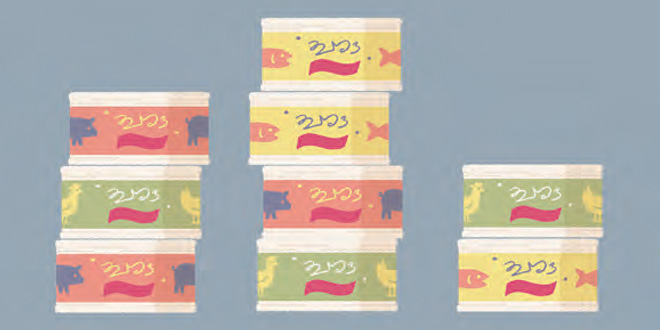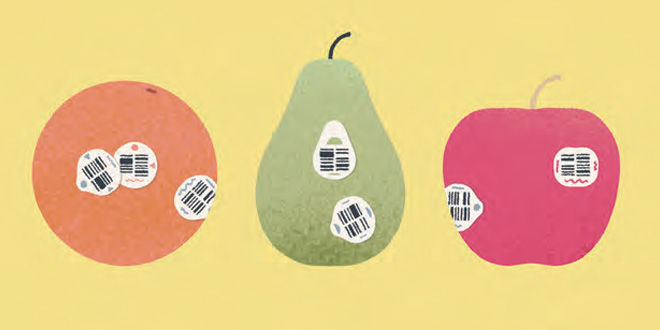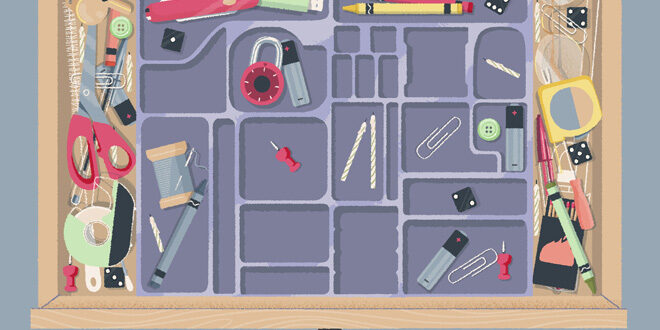 Max Inferno released A Little to the Left late last year, and artist, designer and company co-founder Annie Macmillan told Vince Pavey all about their work on the cosy puzzle game that has you sort, stack, and organise household items.
Max Inferno released A Little to the Left late last year, and artist, designer and company co-founder Annie Macmillan told Vince Pavey all about their work on the cosy puzzle game that has you sort, stack, and organise household items.
After a relatively short time in development compared to most video games (a testament to organisational efficiency based on the puzzles in the game, we’re sure), A Little to the Left is a game that first released and took a lot of people by surprise in November last year as it appeared only a day apart on PC and the Nintendo Switch.
The game maintains a charming art style that reminds us of the opening title sequence to the 1960’s American sitcom I Dream of Jeannie, while the core concept takes the grim chore of cleaning and organising a home and instead makes it both fun and an exercise in being mindful. Quite simply, there’s very little like A Little to the Left out there on the market right now. But how does the idea for a puzzle game based on simple object placement even come about in the first place?
“The concept for A Little to the Left first came to us during the GMTK game jam in 2020, and was inspired by the theme ‘out of control”’ said Max Inferno artist and co-founder Annie Macmillan. “We immediately thought of someone trying to cope with the feeling of being out of control, by turning their focus to the minutiae of their home. We imagined someone straightening picture frames, lining up pencils, and rotating cans so they all faced the same way. We based a lot of the behaviour and objects that you encounter in the game on our own tendencies and objects in our home.”
Once the game jam project had proven to be a success, it wasn’t long before the decision was made to turn it into what we now know as A Little to the Left. The small team also soon decided to double down on the video game version of what other genres of entertainment call ‘magical realism’ in the way it seeks to present its puzzles as the game progresses.
“A lot of people showed interest in this small prototype, so we pushed the idea further when we decided to make it a full game,” Macmillan recalled. “As the game progresses, the things you tidy become a bit more absurd and creative, and the coincidences that exist in this person’s home for discovering the perfect arrangement become highly unnatural. To me, this brings a magical quality, as puzzles are hidden in plain sight.”
OUT OF CONTROL

The team also decided to incorporate elements of chaos into the core gameplay, not only to put an emphasis on freedom, with multiple ways to solve puzzles, but in the introduction of a pet cat that does not care for your oh-so-human organisational wants and needs.
“We enjoyed contrasting the structure that comes with tidying and organising by introducing a cat that will show up occasionally and mess with your tidy work. “The cat also provides a reasoning as to why this house is so messy to begin with.” mused Macmillan. “We also introduced multiple solutions to many of the puzzles to challenge the notion that there is one correct way for things to be. We also introduced a skip option in the game called ‘Let It Be’, which lets you have more control over the levels that you play, and the order in which you play them.”
UNIQUE AND COMFORTABLE

When working on designing the full version of A Little to the Left, it was important to everyone at Max Inferno that the game would maintain a feeling of progression without giving in and following a traditional structured, linear plot. It was far more important for the studio to simply keep things interesting for the player.
“We wanted the game to be comforting to play, but also to be surprising. We wanted to draw the player in and have the game feel like it’s progressing, but we didn’t want to have to rely on a fixed narrative. Every level is visually unique, and we felt like this brings a lot of interest. “Our puzzles are relatively short, so the player becomes interested to see what is next. At first the puzzles are intuitive and simple, like ‘straighten the picture frame’, but later we play with these established rules by turning them on their head; for example, ‘how do you correct a picture frame that is already straightened?’
“We slowly changed the rules on the player, and so we needed the interaction mechanics to be able to gently guide the player in the right direction without being too heavy handed as to reveal the hidden structures at play. For us, this is interesting, and the kind of experience that engages us. We don’t want people to become frustrated, however, so we introduced an interactive hint system and the aforementioned skip option that gives options to the player and makes for a more fun experience.”
PLAYFUL DESIGN

While working on design for A Little to the Left, Macmillan found that rather than looking towards other games for inspiration, she was more influenced by her actions and experiences in her day-to-day life than anything else.
“We were more inspired by our home, our cat, and our own weird ways of tidying up than we were by other games. I realised the other day that the feeling I get when we design these puzzles is the same excitement I get when I’m setting up a scavenger hunt for my nieces and nephews. It’s a childlike playfulness that I hope resonates with people.”
Although she has always been a fan of puzzle games, Macmillan points to one 1997 video game hit in particular as the one that laid the foundations of her love for the genre.
“In terms of games, I was an absolute fan of Riven. It was one of the first games I truly adored, and it really left its mark. I loved the exploration and the environmental puzzles. It is safe to say that it influenced our game; not in any direct way, but it did lay a foundational interest in constructing a world with its own weird internal logic that invites a stranger to try to make sense of. “
When working on an independent game, it came down to some simple rules for Macmillan that we’d suggest all aspiring game developers take to heart:
“Discover what motivates you. Know your strengths. Treat people with respect and kindness. Enjoy the process. Be open. Don’t be too hard on yourself, and have fun!”
During development on A Little to the Left, the biggest issues turned out to be time and team management related, rather than perhaps the design or technical woes that would more typically expect to come with the territory of making an independent game. Thankfully, the team had the support of a well-seasoned publisher and its parent company, which could help them before things got out of hand.
“Our biggest issue was that things just took longer than we planned. This is our first video game project and we had a lot to learn about creating a large scale technical production,” said Macmillan. “We are grateful for the good working relationship we have with our publisher, Secret Mode. They were very good at helping us through production-related blips and helped find us additional resources on the final push to completion.”
LESSONS FROM A LITTLE TO THE LEFT

Having successfully reached the end of development on A Little to the Left with a project they can and should be very proud of, Macmillan is ready to look to the future, having grown as a developer and learned crucial lessons from her last two years of full-scale development. This new knowledge includes the ability to better size-up the requirements of production, and the realisation that the team will probably have to expand.
“This was our first game ever, and we have grown an incredible amount during this process. We learned that project management takes a substantial amount of time when there’s so many aspects to bring together to create a successful video game and Lukas, co-owner of Max Inferno and our lead programmer, handled a lot of the day-to-day business tasks. For the next project we’ll look to have some more programming help. We now have a better idea of how to schedule our time and understand all the pieces required to bring a game to market. I think we are much more confident in our ability to better anticipate the production requirements of another title.”
A Little to the Left has been on digital storefronts since November, and the reaction has been a fairly positive one. As the world has enjoyed its ‘a-ha!’ moments with the puzzles of Max Inferno’s first project, Macmillan seems rather zen about it being out there with audiences at all. It’s reactions are out of her control, after all.
“Our sense is that there are a lot of people out there who enjoy our game! We have been overwhelmed with positive feedback and excitement from players and critics. It’s extremely gratifying to learn about people who laugh at the moments that made us laugh, or to see the penny drop when someone realises the structure behind a particular puzzle. We understand this game isn’t for everyone, and we respect that people have differing preferences and interests. That’s a good thing. But we are so glad to learn there is a large group who do positively resonate with what we’ve made.”

As is often the case with creating works of art, the act of making A Little to the Left itself has been such a positive experience for Max Inferno that it sounds like Macmillan probably would have considered A Little to the Left a success on some level whether it had been a commercial success or not.
“Lukas and I just feel so grateful that we have been able to make something together. It was a success to us, even before the launch. We accomplished a very hard thing that we have never done before, and we had fun doing it. I very much hope that this game is fun for people, and that it brings joy. But it is very abstract and difficult to comprehend how widespread our project is now in the world.” explains Macmillan.
“I look forward to hearing more from individuals, to help it sink in better. But I also don’t want to be too easily swayed, by either positive or negative feedback, when it comes to what it is that Lukas and I decide to make next. The important part for us is that we can continue to be creative and explore ideas together.”

 MCV/DEVELOP News, events, research and jobs from the games industry
MCV/DEVELOP News, events, research and jobs from the games industry




